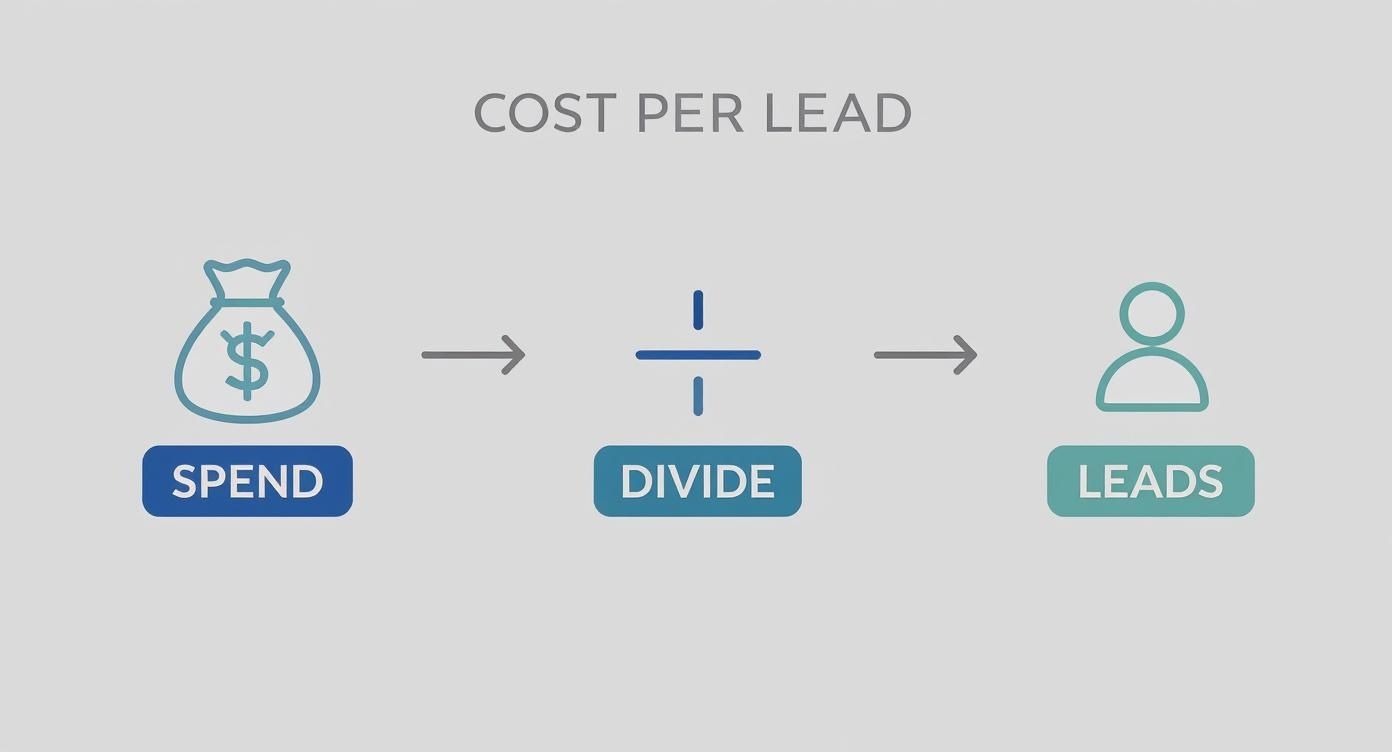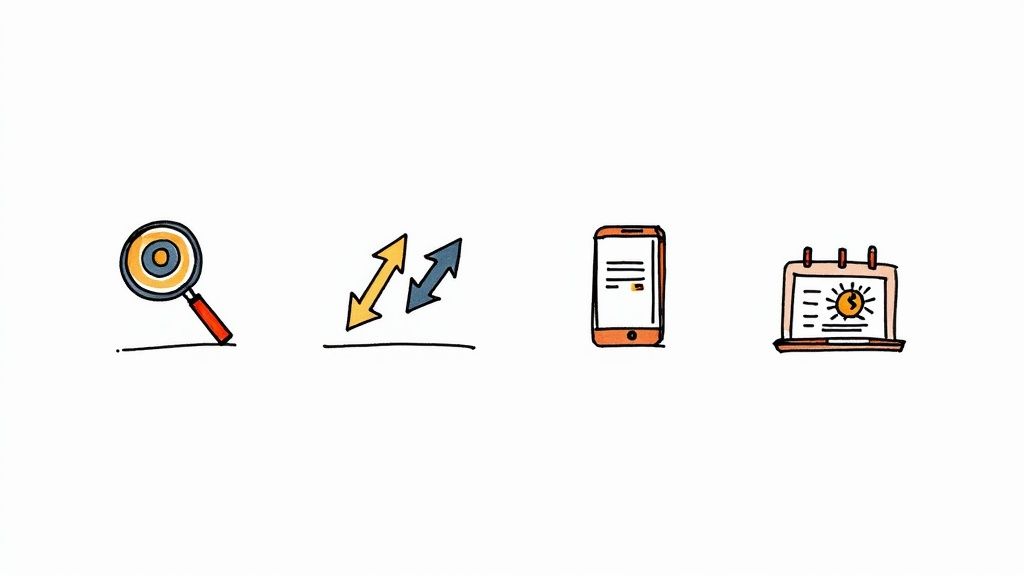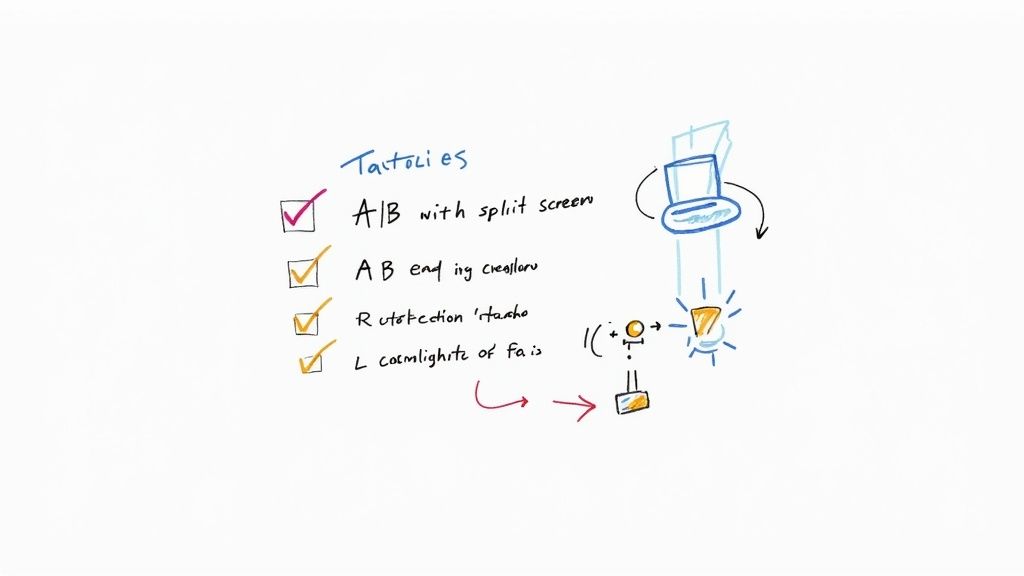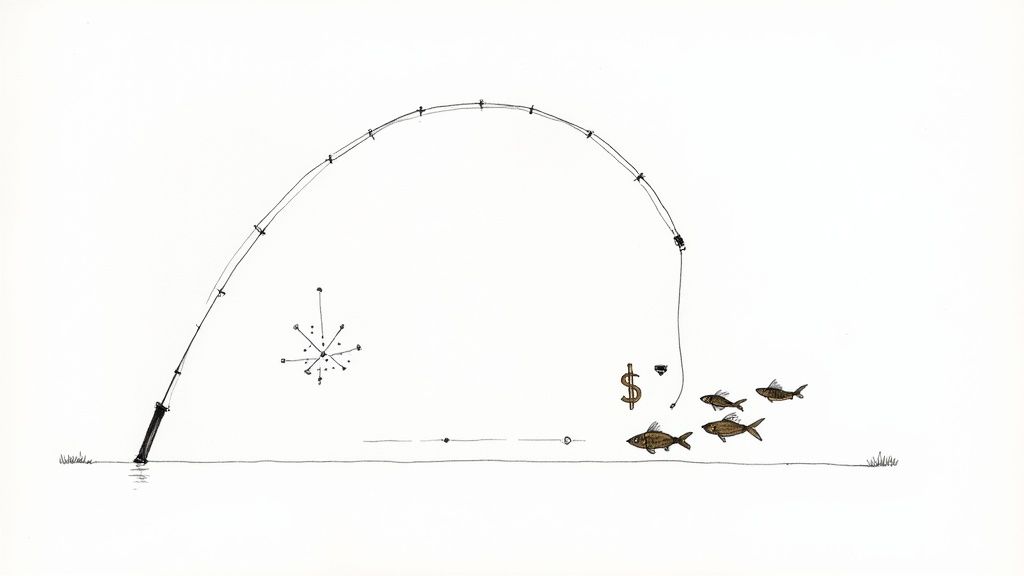Cost Per Lead, or CPL, is a straightforward metric that tells you exactly how much you're spending to get one new potential customer from your marketing. Think of it as the price tag on a "digital handshake"—the moment a prospect raises their hand and shows they're interested in what you offer.
Understanding Your Cost Per Lead

Let's use an analogy. Imagine your marketing campaign is a fishing trip. You spend money on bait (your ads), gear (any software you use), and your time. Your Cost Per Lead is simply the average amount you spent for every single fish you successfully hooked. We're not talking about the ones you sold yet—just the ones that took the bait.
This one number is the bedrock of building a predictable and scalable marketing machine for any home service business. Once you get a firm grip on your CPL, you can finally move past guesswork and start making smart, data-backed decisions about where your money goes.
Why CPL Matters for Your Business
Knowing your Cost Per Lead has a direct impact on your budget, your profits, and your ability to grow. It’s the key that unlocks answers to critical questions.
Specifically, it helps you:
- Spend money smarter: You'll know exactly which marketing channels are bringing in the most affordable leads.
- Spot problems quickly: Easily identify underperforming ads or entire campaigns that are burning through your cash.
- Predict your ROI: You can confidently forecast how many leads a specific budget will generate, making planning much easier.
To get a clearer picture, let's break down the core pieces that make up the Cost Per Lead calculation.
Cost Per Lead Key Components
This table summarizes the essential elements that define and influence your Cost Per Lead.
| Component | Description | Example |
|---|---|---|
| Total Ad Spend | The full amount of money invested in a specific marketing campaign. | $2,000 spent on a Google Ads campaign. |
| Total Leads | The number of new potential customers generated from that campaign. | 100 form submissions or phone calls. |
| CPL Calculation | The simple formula: Total Ad Spend / Total Leads = Cost Per Lead. | $2,000 / 100 leads = $20 CPL. |
Understanding these components is the first step, but it's the context that really matters.
A high CPL isn't automatically bad, and a low CPL isn't always good. The real goal isn't just to get cheap contacts; it's to acquire high-quality leads that actually turn into profitable jobs.
Ultimately, tracking this figure is your starting point for optimizing every single dollar you put into marketing. It ensures your pipeline stays full of real opportunities, not just empty clicks.
Figuring Out Your True Cost Per Lead
At first glance, calculating your cost per lead seems easy enough. But getting a number you can actually trust? That's a bit more involved. The devil, as they say, is in the details.
The basic formula itself is simple:
Cost Per Lead (CPL) = Total Marketing Campaign Spend ÷ Total New Leads Generated
This little equation is your starting point for measuring how well any marketing campaign is really performing. The tricky part, and where most people get it wrong, is figuring out what actually goes into "Total Spend" and what truly counts as a "Total Lead." Get these wrong, and you're flying blind with a CPL that looks great on paper but is completely misleading.
What to Include in Your Total Marketing Spend
To get a real CPL, you have to look beyond just what you paid for the ads. You need to account for every single dollar that went into making that campaign happen. It's the only way to get a clear picture of your efficiency.
Your Total Marketing Spend should always include:
- Ad Spend: This is the obvious one—the money you paid directly to Google, Facebook, or any other platform.
- Creative Costs: Did you hire a designer for the ad visuals? A copywriter for the text? Those costs count.
- Tools & Software: Think about your CRM, analytics tools, or marketing automation software. A portion of their subscription fees belongs here.
- Team Hours: Don't forget the time your own team spent on the campaign. Their salaries are a real cost.
Adding up all these expenses gives you a holistic view and stops you from underestimating your true cost per lead. This same thinking applies when you're figuring out how to calculate customer acquisition cost, which also demands a full accounting of every related expense to be accurate.
Defining What Actually Counts as a "Lead"
Next up, you have to get crystal clear on what you consider a "lead." This can change from one business to another, but whatever you decide, you have to stick with it for your numbers to mean anything. A lead isn't just a website click; it's a new prospect showing real, tangible interest.
For a home service business, a lead is typically one of these actions:
- Someone fills out the contact form on your website asking for a quote.
- You get a phone call from a potential new customer.
- A direct message lands in your social media inbox from someone asking about your services.
Once you know exactly what you're tracking and have tallied up all the associated costs, you can finally calculate a CPL that’s worth its salt—one you can confidently use to make smarter decisions about where to put your marketing budget.
What Is a Good Cost Per Lead
So, what’s a "good" cost per lead? That’s a bit like asking how much a good car should cost. The answer is always the same: it depends. There's no magic number that fits every business, and blindly chasing the lowest possible CPL is a rookie mistake that usually brings in low-quality prospects.
A "good" CPL is entirely relative to your own business. It all boils down to your average sale price and what a customer is worth to you over the long haul. A cost that’s a fantastic deal for one company could easily put another out of business.
Finding Your Profitable CPL
Let's put this into perspective. A $150 CPL might make you wince at first. But what if you're a roofer, and your average project is worth $10,000? Suddenly, paying $150 to get a shot at that job seems like an incredible deal. The return on investment is huge.
On the flip side, that same $150 CPL would be a total disaster for a pest control business selling a $50 one-time service. You’d be losing money on every single lead. The math just doesn't work.
The real question isn’t “What is a good CPL?” but rather, “What CPL is profitable for my business?” Your ideal cost per lead must be significantly lower than the revenue a typical customer generates over their lifetime.
This simple visual breaks down how CPL is calculated: just divide your total marketing spend by the number of new leads you brought in.

Getting a handle on this basic formula is the very first step to figuring out what a healthy and sustainable CPL looks like for your company.
Benchmarks Provide Context, Not Rules
While your own bottom line should always be your guide, looking at industry benchmarks can be helpful. They give you a little context and show you how your numbers stack up against the competition, which can be a great way to spot areas where you could be doing better.
For instance, here are a few average CPLs for industries related to home services:
- Construction: The average CPL hovers around $227.
- IT & Managed Services: You're looking at an average CPL of about $501.
- Financial Services: The average CPL can climb as high as $461.
Treat these numbers as a reference point, not a strict target. Your true goal is to find that sweet spot where you're consistently attracting high-quality leads at a cost that allows your business to grow profitably.
The Key Levers That Control Your Cost Per Lead

Your Cost Per Lead isn’t some random number pulled from thin air. It’s the direct result of a handful of interconnected forces pushing and pulling on your marketing efforts.
Think of it like the price of a gallon of gas—it shifts based on things like supply, demand, and how efficiently your car runs. Getting a handle on these forces is the first step to actually controlling what you spend.
Let's break down the four main areas that have the biggest impact on what you ultimately pay for each lead.
Your Competitive Battlefield
The industry you're in sets the stage. If you're a roofer in a major city, you're competing with dozens of other companies for the same eyeballs and keywords. That’s a crowded auction, and it naturally drives up the price for everyone involved.
For example, the average CPL for a construction business hovers around $227, while a B2B software company might see something closer to $188. The more players on the field, the higher the cost of admission.
The Art of Audience Targeting
Who you’re talking to is just as important as what you're saying.
Running ads with broad, sloppy targeting is like trying to catch a specific fish with a giant net—sure, you’ll catch a lot of stuff, but most of it won't be what you wanted. It’s a classic way to burn through your budget and drive your CPL through the roof.
On the other hand, sharp, precise targeting is like using the perfect bait for the exact fish you’re after. You get fewer nibbles, but the ones you do get are the right ones. This dramatically lowers the cost for each good lead.
A sky-high CPL is often a red flag for a targeting problem. Are you showing ads to people outside your service area? Or to homeowners who just aren't looking for what you offer?
Ad Creative and Landing Page Experience
Even if you nail your targeting, a boring ad or a clunky landing page will sink your campaign. Your ad has to grab someone's attention and make a clear promise, and the landing page needs to deliver on that promise without any friction.
A few things can go wrong here:
- The Mobile Experience: Is your landing page a pain to use on a smartphone? If it’s slow or hard to navigate, you can easily double your CPL. People just won't stick around.
- A Clear Call-to-Action (CTA): Is it dead simple to understand what the next step is? If your "Get a Quote" button is buried or confusing, potential leads will just bounce.
Seasonal Ebbs and Flows
Demand for most home services isn't a flat line—it goes up and down with the seasons, and your CPL will ride that same wave.
An HVAC company knows CPL will jump during a sweltering summer heatwave because every competitor is throwing money at ads. A plumber might find leads are cheaper in the fall but much harder to come by. Learning to anticipate these rhythms lets you budget and plan your campaigns much more effectively.
Actionable Strategies to Lower Your Cost Per Lead

Knowing what pushes your CPL up is half the battle. The other half is actively bringing it down. The great news is you have more control over your CPL than you might think. With a smart, focused approach, you can cut your costs and, at the same time, boost the quality of the leads you're getting.
This isn’t about just cutting your budget indiscriminately. It's about making every single dollar you spend work smarter and harder. By fine-tuning your tactics, you can pull in more qualified prospects without increasing—or maybe even while decreasing—your ad spend.
Laser-Focus Your Audience Targeting
Want to know the quickest way to waste money and send your CPL through the roof? Show your ads to people who don't need or want your services. Casting a wide net is almost always an expensive and ineffective strategy. The key is to get incredibly specific about who you're talking to.
Drill down into the details: demographics, online behaviors, and especially location. If you run a home service business, for instance, you should be using tight geographic targeting to ensure your ads are only seen by homeowners within your actual service area. You can take it even further by layering on interests that signal someone is ready to buy, like targeting users who recently searched for "emergency plumber" or "kitchen remodel ideas."
Never Stop A/B Testing Your Campaigns
Your first ad, email, or landing page is rarely your best. That's where A/B testing comes in. It's a simple but powerful idea: you create two versions of a marketing asset and run them against each other to see which one performs better. This takes the guesswork out of the equation and gives you hard data to drive improvements, which in turn lowers your CPL.
You can test almost any element, but it's best to start with the ones that make the biggest impact.
- Ad Headlines: Try out a few different hooks. Does a question work better than a statement?
- Images and Videos: See what kind of visuals truly connect with your audience.
- Calls-to-Action (CTAs): Test different button text. Does "Get a Free Quote" outperform "Schedule a Consultation"?
- Landing Page Layouts: Does a simple, short form convert better than a more detailed one?
Harness the Power of Retargeting
Very few people are ready to become a lead on their first visit to your website. That’s perfectly normal. Retargeting gives you a second (and third, and fourth) chance to connect by showing specific ads to people who have already visited your site. It keeps your brand fresh in their minds while they're still in the decision-making phase.
This strategy is incredibly cost-effective. You're no longer talking to a cold audience; you're marketing to warm prospects who have already shown genuine interest. It's no surprise that the CPL for retargeting campaigns is often a tiny fraction of what it costs to acquire a completely new prospect.
Putting these proven tactics into practice is essential. Of course, direct outreach is still a potent tool, and you can learn more about what to expect by checking out typical cold calling conversion rates in our guide. For those in the B2B space, applying these same principles within the larger context of effective B2B lead generation strategies is absolutely critical for long-term growth.
Digging Deeper: Your Top CPL Questions Answered
Once you start tracking CPL, you’ll find that a few questions almost always come up. It's a simple metric on the surface, but some of the nuances can be tricky. Let’s clear up some of the most common points of confusion to help you make smarter decisions.
Is a Lower CPL Always Better?
Not at all. While a low CPL might look impressive on a spreadsheet, it can often be a warning sign that you're attracting low-quality leads. It's the classic "you get what you pay for" scenario.
Think about it: would you rather pay $50 for a homeowner who is actively looking for bids and ready to hire, or $5 for someone who accidentally clicked your ad and has zero interest in your services? The real goal isn't just to get the cheapest leads, but to find that sweet spot—a reasonable cost for a lead that actually has a good chance of turning into a paying customer.
A much more powerful metric to track is your Cost Per Qualified Lead. This sharpens your focus on the people who are a perfect fit for your business, giving you a far more accurate picture of how effective your marketing really is.
What's the Difference Between CPL and CPA?
This is a big one, and it's easy to get them mixed up. The key is that they measure two completely different milestones in your sales process.
-
CPL (Cost Per Lead): This is what it costs you to get a potential customer on the hook. It’s someone who has raised their hand and shown interest, but they haven't spent a dime yet.
-
CPA (Cost Per Acquisition): This measures what it costs to land an actual paying customer. It tracks the final conversion—the signed contract or the completed job.
Put simply, CPL measures interest, while CPA measures revenue. You could have a campaign with a fantastic CPL, but if none of those leads ever book a job, your CPA will be through the roof. A situation like that tells you there's a serious problem somewhere between generating the lead and closing the sale.
Ready to stop worrying about lead costs and start filling your calendar with qualified appointments? Phone Staffer offers done-for-you cold calling and can place highly trained remote CSRs in your business to ensure no lead is ever wasted. Learn how we can help you grow.

